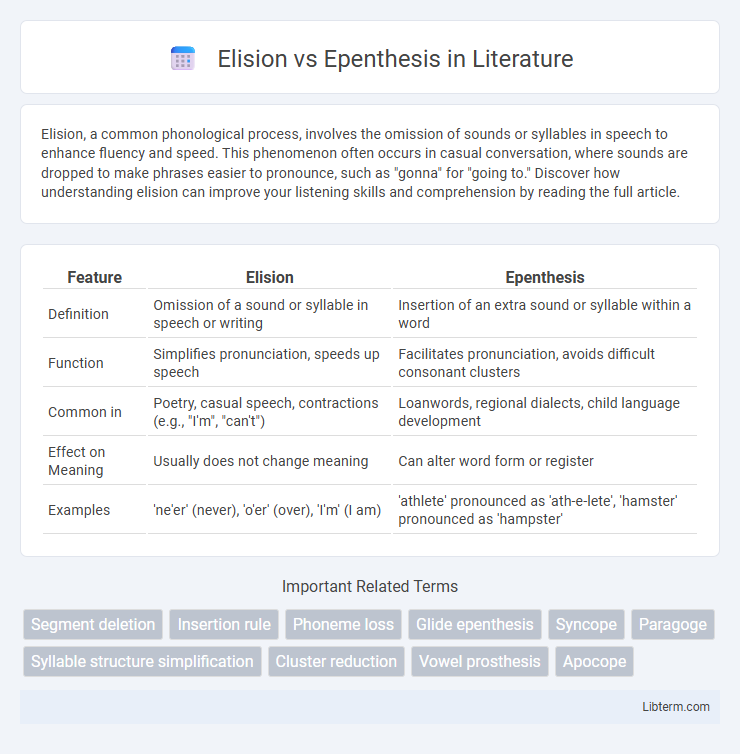Elision, a common phonological process, involves the omission of sounds or syllables in speech to enhance fluency and speed. This phenomenon often occurs in casual conversation, where sounds are dropped to make phrases easier to pronounce, such as "gonna" for "going to." Discover how understanding elision can improve your listening skills and comprehension by reading the full article.
Table of Comparison
| Feature | Elision | Epenthesis |
|---|---|---|
| Definition | Omission of a sound or syllable in speech or writing | Insertion of an extra sound or syllable within a word |
| Function | Simplifies pronunciation, speeds up speech | Facilitates pronunciation, avoids difficult consonant clusters |
| Common in | Poetry, casual speech, contractions (e.g., "I'm", "can't") | Loanwords, regional dialects, child language development |
| Effect on Meaning | Usually does not change meaning | Can alter word form or register |
| Examples | 'ne'er' (never), 'o'er' (over), 'I'm' (I am) | 'athlete' pronounced as 'ath-e-lete', 'hamster' pronounced as 'hampster' |
Introduction to Elision and Epenthesis
Elision is the phonological process where one or more sounds are omitted from a word or phrase, commonly occurring in rapid or casual speech to simplify pronunciation, such as the dropping of the /t/ sound in "next day" pronounced as "nex day." Epenthesis involves the insertion of an extra sound, often a vowel or consonant, within a word to break up difficult consonant clusters or to conform to preferred phonotactic patterns, exemplified by the insertion of a vowel in "athlete" pronounced as "ath-e-lete." Both processes serve to enhance speech fluidity and ease of articulation but operate in opposite manners, with elision reducing segments and epenthesis adding segments.
Defining Elision: Meaning and Examples
Elision is the phonological process where sounds, typically vowels or consonants, are omitted in speech to facilitate smoother and quicker pronunciation. Common examples include the omission of the vowel sound in "family" pronounced as "famly" or the consonant in "friendship" pronounced as "frenship." This process enhances fluency in natural conversation by reducing syllable count and simplifying complex sound clusters.
Understanding Epenthesis: Meaning and Examples
Epenthesis is a phonological process involving the insertion of an extra sound, typically a vowel or consonant, within a word to simplify pronunciation or clarify meaning. Common examples include the addition of a vowel in "athlete" pronounced as "ath-e-lete" or a consonant in "hamster" pronounced as "hampster." This linguistic phenomenon aids in easing articulation and often occurs in rapid or casual speech across various languages.
Key Differences Between Elision and Epenthesis
Elision involves the omission of a sound or syllable in speech, commonly occurring to simplify pronunciation in fast or connected speech, such as dropping the "t" in "next day." Epenthesis is the addition of a sound or syllable within a word to break up difficult consonant clusters, like inserting a vowel in "athlete" pronounced as "ath-e-lete." The key difference lies in elision reducing sounds to ease flow, whereas epenthesis inserts sounds to enhance clarity or articulation.
Linguistic Functions of Elision
Elision serves a key linguistic function by streamlining speech and enhancing phonological fluency, often occurring in rapid or casual conversation to omit sounds, such as vowels or consonants, within words or between adjacent words. This process improves speech economy, making communication more efficient and natural, particularly in connected speech where ease of articulation is prioritized. In contrast, epenthesis involves the insertion of sounds to prevent difficult consonant clusters or to maintain syllable structure, serving a different role in phonotactic adjustment.
Linguistic Functions of Epenthesis
Epenthesis functions linguistically by inserting a vowel or consonant to break up difficult consonant clusters, facilitating smoother pronunciation and enhancing phonological clarity. This process aids in maintaining the rhythmic and syllabic structure of words, thus supporting more fluid speech patterns. Epenthesis also serves as a morphophonemic tool, helping to preserve morphological boundaries and ease the integration of affixes.
Phonological Environment and Triggers
Elision occurs in rapid speech when phonemes, typically vowels or consonants, are omitted to facilitate smoother pronunciation, often triggered by adjacent similar sounds or unstressed syllables within a connected speech context. Epenthesis involves the insertion of an additional phoneme, commonly a vowel or consonant, to break up complex clusters or awkward transitions, frequently triggered by morphological boundaries or the need for syllable structure repair. Both processes are sensitive to the phonological environment, such as syllable position, stress patterns, and neighboring segment features, influencing their application to maintain phonotactic constraints.
Elision and Epenthesis in Different Languages
Elision involves the omission of sounds or syllables in speech, commonly found in languages like French, where unstressed vowels are often dropped to maintain rhythm, and English, where consonants may be elided in casual speech (e.g., "next day" pronounced as "nex day"). Epenthesis, the insertion of extra sounds within words, occurs in languages such as Japanese, which inserts vowels to break up consonant clusters incompatible with its phonotactic rules, and Arabic, where an epenthetic vowel can be added to ease pronunciation. These processes reflect languages' adaptations to phonological constraints, with elision streamlining sound patterns and epenthesis facilitating easier articulation.
Impact on Pronunciation and Speech Clarity
Elision reduces speech clarity by omitting sounds within words or between words, often leading to faster but less distinct pronunciation in natural conversation. Epenthesis enhances clarity by inserting extra sounds to maintain syllable structure and ease articulation, particularly in loanwords or challenging consonant clusters. Both processes influence pronunciation, with elision favoring fluency and epenthesis improving intelligibility in spoken language.
Conclusion: Significance in Phonological Analysis
Elision and epenthesis serve as crucial processes in phonological analysis by illustrating how languages manage syllable structure and sound patterns to maintain phonotactic constraints. Elision involves the omission of sounds to simplify consonant clusters or unstressed syllables, while epenthesis adds sounds to resolve disallowed sequences or enhance pronunciation clarity. Understanding these phenomena provides insights into language evolution, speech rhythm, and the cognitive mechanisms underlying spoken communication.
Elision Infographic

 libterm.com
libterm.com